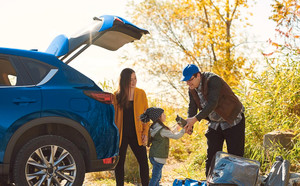Toronto to Calgary Road Trip: Routes & Tips
By Kijiji Autos
Whether travelling for business or pleasure, one great way to get from Toronto to Calgary is a good old-fashion road trip. The adventure may take significantly longer than flying, but there are bonuses to driving your own way. For one, the long road between the two metropolitans showcases some of North America’s most treasured landscapes. And for another, operating your own trip means that you can accommodate your needs, cargo and other essentials along the way.
Make no mistake: the pilgrimage from Ontario to the Rocky Mountains is long—and longer still when travelling in poor conditions, such as winter. Your road trip needs to begin with a plan, including how to get there, where to stop and what you might need to make your journey a smooth one. Thankfully, this article is here to help with your itinerary. Keep reading, and get ready for your cross-country adventure.
Planning your trip from Toronto to Calgary
Your first stop in planning your Toronto to Calgary road trip is figuring out how to get there. Unsurprisingly, there are several different routes that will get you to your Albertan destination.
Below we will cover the two most direct routes and the positives and negatives of each choice. The two options will serve you well as your primary paths, while preferred stops and detours can be included from there. Let’s look at the two main routes between Toronto and Calgary.
Canadian/American border route
The first route we are going to look at is the fastest but requires a bit more planning. The path involves crossing the border into the United States and returning to Canada once you're further along—so, don’t forget those passports. The trip is an estimated 3,400 km, which involves about 33 to 35 hours of non-stop driving. Subsequently, the path will have you crossing through multiple US states and Canadian provinces, which will require you to know the driving laws between each designation.
The Canadian/American route will have you travel through each of these states and provinces:
- Ontario
- Michigan
- Indiana
- Illinois
- Wisconsin
- Minnesota
- North Dakota
- Saskatchewan
- Alberta
Alongside the border crossings, this path does include toll stations, so you may also need some American cash on hand. Something else to keep in mind: there isn't just one direct roadway, so you will be required to know which highways to take throughout your trip. However, there are some bonuses to this route, beyond being the fastest method. The trip will explore some great US destinations, such as Chicago and Minneapolis, with Detroit and Milwaukee possible pitstops. Still, with the multiple roadways and state and provincial driving laws, it's recommended that only experienced drivers attempt this path—especially in poor winter driving conditions, which can cause slippery roads and low visibility.
Canada-only route
The next route between Toronto and Calgary is worth considering and is far more straightforward but may add some extra time to your trip. Estimated to be around 3,420 km long, the Canada-only route will take at least 36 hours of non-stop driving. However, without needing to cross international borders, it could potentially save time in the long run. And while you will not need to worry about bringing your passport, they are still a good thing to have on hand, just in case.
The great thing about taking this route is that you only need to remember one road: the Trans-Canada Highway. Established in the early 1960s, the Trans-Canada Highway was intentionally designed for travels from coast to coast, hitting the most prominent cities along the way, including Calgary and Toronto. Travelling through Ontario, Manitoba, Saskatchewan and Alberta, it will be much easier to know your route and make additional plans and accommodations throughout.
Always keep in mind that the trip will take even longer while driving in the winter. The estimated time for travel is based on optimal conditions, usually only seen in the summer. Winter driving is typically far slower than in the summer, which you're well aware of if you're from the Great White North. Meanwhile, overnight stays and food stops will undoubtedly be a requirement. Both routes take most drivers between four and five days, driving from dusk 'til dawn.
Any additional stops will, of course, extend your trip further and require you to plan accordingly.
Other considerations - Winter Driving
Aside from a well-planned route, there are lots of other things to consider when travelling long distances by vehicle. Prominently, consider the vehicle that you intend on driving. You will need to estimate how much fuel you'll need, any maintenance that may come up and ensure that your vehicle is prepared for winter driving i.e., anti-freezing washer fluid and winter tires. If you're driving an electric vehicle, keep in mind where and when you can reach a charging station. Further expenses will include food, accommodations and any other needs. Don't forget to keep comfort in mind. Spending over 30 hours in a vehicle can take its toll—it's best to drive while rested and aware, so be sure to plan stops and places to sleep as needed.
Safety considerations During Winter
Safety needs to be at the top of your list when doing any long-distance travelling—especially a Toronto to Calgary road trip in winter. Make sure your vehicle is in prime condition before leaving, as maintenance on the side of the road during winter conditions can be uncomfortable and risky. Included in car maintenance is assuring your vehicle is winter-ready, with tires, anti-freezing windshield washer fluid and a good window scraper all being necessities.
Additionally, be aware of weather conditions on your path before and during your travels, and make accommodations as needed. Only drive when you're fully alert, with driving during daylight hours being optimal—remember that there's less daylight during the winter than in the summer months. Finally, be prepared for dynamic road conditions, including slippery roadways, twisty highways and unpredictable wildlife. This is Canada, after all.
Where should you stop along the way?
Travelling such a long way doesn't have to be boring. There are some amazing sites to see and great places to stop no matter which route you take. Remember that you can always add detours and stops that may be out of your way, provided you're okay with adding extra time to your journey. With plenty of bustling cities and scenic parks between Ontario and Alberta, there will surely be places worth visiting. Let’s look at some potential highlights and recommendations of beautiful spots to check out on your road trip.
Points of interest if you're taking the Canadian/American route:
- Lake Michigan
- Helena-Lewis And Clark National Forest
- Theodore Roosevelt National Park
- Upper Missouri River Breaks National Monument
- Banff National Park
Points of interest if you're taking the Canada-only route:
Items to bring with you
Don’t forget the essentials. As mentioned, there are some things that will be required for you to travel, including passports. However, there are lots more to consider. To help you with your checklist, here are a few must-haves to make your road trip safe, comfortable and convenient:
- First-aid kit
- Blankets/sleeping bags
- Portable phone charger
- Flashlights with extra batteries
- Snow brush and ice scraper
- Portable car battery jump starter
- Collapsible snow shovel
- Winter clothes (if travelling during winter)
- Extra water and snacks
Tips for travelling
Long road trips require quite a bit of planning, and the more you figure out ahead of time, the smoother your journey will be. However, incidents can happen that aren't in our control. For the safest and most successful road trip, here are some key things to keep in mind while driving.
Take your time. Driving long distances isn't about speed—it's a marathon. Driving safely is worth it, including following speed limits, respecting provincial and state driving laws and being patient with fellow drivers.
Keep your plans flexible. Sure, you worked hard at planning the perfect route, with every stop accounted for, but sometimes things come up that will slow your trip down. Be prepared to have to pay for an extra night or two of accommodations if necessary, and make sure your phone charger is with you and working, in case you need to change your route at the last minute.
Additionally, keep a close eye on weather conditions in areas throughout your trip that may require you to change directions or plans.
Finally, watch out for moose and other wildlife on the road. And most importantly, have fun!
Planning a long road trip but don't have the proper vehicle to withstand the journey? Searching for your next automobile is easier than ever with the extensive catalogue of new and used vehicles on Kijiji. Using the easy-to-use search tools and available online financing, find the perfect ride to take with you on your cross-country road trip.
Easily find your next ride on Kijiji Autos
Search nowHow Long Can a Car Sit Unused?
How long can a car be left without starting it? Keep reading to explore everything you need to know about unused cars.Costs of Installing an Electric Car (EV) Charging Station in Canada
Installing a home EV charger can come with additional fees beyond purchase and installation. Here's a list of factors that can affect the price of a home EV charger.Flat Tire vs Blowout: What's the Difference & What Should You Do?
The main difference between a flat tire and a blowout is that a blowout often feels like an explosion has occurred underneath your vehicle. Blowouts can cause sudden and drastic changes to the handling of your vehicle and can lead to minor or even serious accidents.7 items you can fit in an SUV: TVs, mattresses and more
Discover seven common items that fit in an SUV below.Tips to help protect your vehicle and budget for car repairs
When shopping for your next vehicle, it's always a good idea to keep hidden costs in mind. Before you buy, let's look at how much it can cost to maintain a car in Canada, how much you could budget for annual maintenance and repairs, and how to help protect your car against damage and depreciationThe top three best paint protection options for your vehicle
Buying a new vehicle is a great experience. Nothing beats hitting the road in a car you bought fresh off the lot. However, as fun as it is to finally get behind the wheel of your new ride, it's important to take your time through the process.What is the value of undercoat protection on your vehicle?
When you buy a new vehicle, protecting it so that it lasts as long as possible is definitely top of mind, whether that's through security upgrades or an extra coat of paint. But how often do you consider the care and safety of your vehicle’s undercarriage?Financial guide: post-pandemic car shopping and gas price hacks
With populations locked down and international borders closed the global supply chain has been disrupted on a massive scale, pushing up inflation around the world and raising the cost of everything that people need to get back to normal. Here are a few tips you can use to grab the vehicle you want without breaking the bank.10 tips to help make the road a better and happier place
We have all, at some point, been responsible for making the roadways stressful in one way or another. Alternatively, we are all equally capable of making the road a happier place. Let’s explore 10 unique ways we can help make the driving experience better again, for everyone's sake.10 eco-driving tips that can help you save money and reduce your carbon footprint
With rising gas prices, carbon taxes on fuel and concerns about climate change, many Canadians are wondering how to save gas when driving. Experts recommend adopting eco-driving techniques that can help you save money and fuel. Read on to discover 10 of them:









